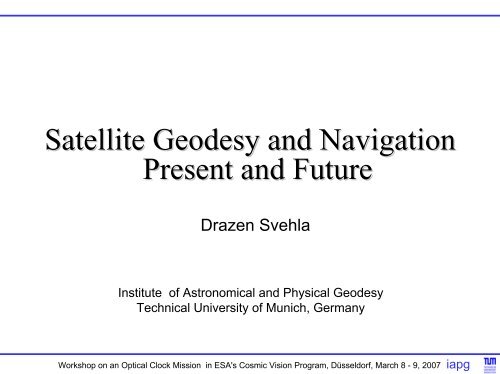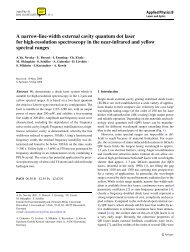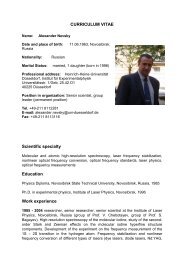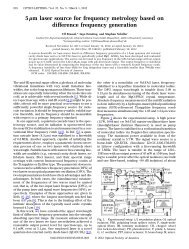Drazen Svehla_Vision.pdf - Quantum Optics and Relativity
Drazen Svehla_Vision.pdf - Quantum Optics and Relativity
Drazen Svehla_Vision.pdf - Quantum Optics and Relativity
You also want an ePaper? Increase the reach of your titles
YUMPU automatically turns print PDFs into web optimized ePapers that Google loves.
Satellite Geodesy <strong>and</strong> Navigation<br />
Present <strong>and</strong> Future<br />
<strong>Drazen</strong> <strong>Svehla</strong><br />
Institute of Astronomical <strong>and</strong> Physical Geodesy<br />
Technical University of Munich, Germany<br />
Workshop on an Optical Clock Mission in ESA's Cosmic <strong>Vision</strong> Program, Düsseldorf, March 8 - 9, 2007<br />
iapg
� Clocks for navigation<br />
Content<br />
� Relativistic geodesy on the ground<br />
� Planetary relativistic geodesy<br />
� Clocks for GPS radio-occultation <strong>and</strong> GPS altimetry<br />
� Can clock improve the GPS receiver performance?<br />
� Master clock in the Molniya type orbit<br />
� Pioneer anomaly – two master clocks in the planetary mission<br />
� Master clocks in Lagrange points: Planetary Navigation System<br />
Workshop on an Optical Clock Mission in ESA's Cosmic <strong>Vision</strong> Program, Düsseldorf, March 8 - 9, 2007<br />
iapg
GPS Satellite Clocks<br />
• GPS satellite clock variations can easily reach several nanoseconds!<br />
• For the real time GPS applications we need a possibility to predict clock variation with an<br />
accuracy below 1 cm for a period of 1 hour (
(Colorado Springs – USNO)<br />
Root<br />
drift 1/ f<br />
Ground Phase Clocks<br />
≈ 200 s<br />
≈ 200 s<br />
white noise<br />
Only phase clocks estimated.<br />
Troposphere (TZD), station coord., EOPs,<br />
etc., fixed to IGS<br />
Clear white noise up to 200 s<br />
<strong>and</strong> frequency drift with 1/f<br />
Workshop on an Optical Clock Mission in ESA's Cosmic <strong>Vision</strong> Program, Düsseldorf, March 8 - 9, 2007<br />
(2.9×10 -16 /day)<br />
≈ 7 mm<br />
Stability of GPS<br />
receiver <strong>and</strong><br />
H-maser<br />
iapg
A<br />
E A<br />
B<br />
B<br />
Relativistic Geodesy on the Ground<br />
B’<br />
B’’<br />
geoid<br />
ellipsoid<br />
B C E<br />
... ...<br />
C = C + gdn + gdn + gap + gdn<br />
∫<br />
H = gdn<br />
spirit leveling<br />
∫ ∫ ∫<br />
A B D<br />
r<strong>and</strong>om walk effect<br />
50 m<br />
ACES<br />
MW-link<br />
C D<br />
B<br />
B′<br />
Ellipsoid: Geometry measured with GPS<br />
HGeoid:<br />
Gravity measured with gravimetry (clocks)<br />
ACES to help in the:<br />
→ realization of the World height system<br />
→ combination of space/ground gravimetry<br />
Clocks can be used to determine in situ geopotential numbers globaly<br />
Workshop on an Optical Clock Mission in ESA's Cosmic <strong>Vision</strong> Program, Düsseldorf, March 8 - 9, 2007<br />
iapg<br />
E
Degree St<strong>and</strong>ard Deviations in Geoid Heights [m]<br />
10 -1<br />
10 -2<br />
10 -3<br />
10 -4<br />
10<br />
10<br />
20<br />
20<br />
CHAMP & GRACE Gravity Field Models<br />
CHAMP Mean Fields<br />
30<br />
1cm ≈ 0.1m 2 /s 2<br />
30<br />
Degree<br />
Error degree variances<br />
for CHAMP <strong>and</strong> GRACE gravity fields<br />
40<br />
40<br />
50<br />
EIGEN-3P error un-calibrated<br />
TUM2S error un-calibrated<br />
EIGEN-3P minus TUM2S<br />
EIGEN-3P minus ITG-CHAMP01S<br />
TUM2S minus ITG-CHAMP01S<br />
CHAMP prediction<br />
2<br />
m<br />
1 cm /1000km → 0.1 /1000km<br />
2<br />
s<br />
50<br />
60<br />
60<br />
10 -1<br />
10 -2<br />
10 -3<br />
10 -4<br />
Degree<br />
Workshop on an Optical Clock Mission in ESA's Cosmic <strong>Vision</strong> Program, Düsseldorf, March 8 - 9, 2007<br />
Degree St<strong>and</strong>ard Deviations in Geoid Heights [m]<br />
10 -1<br />
10 -2<br />
10 -3<br />
10 -4<br />
10 -5<br />
GRACE Combined Mean Fields<br />
50<br />
1cm ≈ 0.1m 2 /s 2<br />
50<br />
100<br />
100<br />
150<br />
(Gruber 2005)<br />
GGM2C error calibrated<br />
EIGEN-CG03C error calibrated<br />
GGM2C minus EIGEN-CG03C<br />
GRACE prediction<br />
150<br />
2<br />
m<br />
1 cm / 400km → 0.1 / 400km<br />
2<br />
s<br />
iapg<br />
10 -1<br />
10 -2<br />
10 -3<br />
10 -4<br />
10 -5
spherical<br />
harmonics<br />
degree/order<br />
=100<br />
EGM96<br />
(Gruber 2005)<br />
Latitude<br />
Comparison with GPS-levelling geoid heights<br />
Latitude<br />
0<br />
0<br />
10<br />
10<br />
20<br />
20<br />
Longitude<br />
30<br />
30<br />
39.9999<br />
70 70<br />
60 60<br />
50 50<br />
40 40<br />
39.9999<br />
-1.29 -1.09 -0.89 -0.69 -0.49 -0.29 -0.09 0.11 0.31 0.51 0.71<br />
230 240 250 260 270 280 290 300<br />
60 60<br />
50 50<br />
40 40<br />
30 30<br />
20 20<br />
230 240 250 260 270 280 290 300<br />
Longitude<br />
-0.95 -0.75 -0.55 -0.35 -0.15 0.05 0.25 0.45 0.65 0.85 1.05<br />
1 m ≈ ∆f/f=1·10 -16<br />
20<br />
Longitude<br />
Workshop on an Optical Clock Mission in ESA's Cosmic <strong>Vision</strong> Program, Düsseldorf, March 8 - 9, 2007<br />
Latitude<br />
Latitude<br />
0<br />
0<br />
10<br />
10<br />
20<br />
30<br />
30<br />
39.9999<br />
70 70<br />
60 60<br />
50 50<br />
40 40<br />
39.9999<br />
-1.29 -1.09 -0.89 -0.69 -0.49 -0.29 -0.09 0.11 0.31 0.51 0.71<br />
GRACE<br />
EIGEN-CG03C<br />
230 240 250 260 270 280 290 300<br />
60 60<br />
50 50<br />
40 40<br />
30 30<br />
20<br />
230 240 250 260 270 280 290<br />
20<br />
300<br />
Longitude<br />
-0.95 -0.75 -0.55 -0.35 -0.15 0.05 0.25 0.45 0.65 0.85 1.05<br />
iapg
GPS-<br />
Levelling<br />
Data Set<br />
Comparison with GPS-Levelling Geoid Heights<br />
• Model up to d/o 60<br />
• Omission error from d/o 61 to d/o 720 estimated from GPM98 model<br />
(Wenzel)<br />
• GRACE models: GGM02S, GGM02C, EIGEN-GRACE02S, EIGEN-CG03C,<br />
Monthly models for 2004-03.<br />
• Editing criteria: 3*sigma<br />
0.5 m ≈∆f/f=5·10 RMS [m]<br />
-17<br />
Num.<br />
Points<br />
EGM96 TUM2S<br />
(CHAMP)<br />
EIGEN-<br />
3P<br />
GRACE<br />
Models<br />
USA 5139 0.400 0.441 0.401 0.400<br />
Canada 1564 0.477 0.515 0.474 0.467<br />
Europe 177 0.372 0.298 0.250 0.237<br />
Germany 660 0.255 0.173 0.124 0.155<br />
Australia 195 0.495 0.524 0.500 0.469<br />
Japan 828 0.512 0.482 0.476 0.491<br />
* GPS-Levelling Data for Australia, Japan <strong>and</strong> Germany provided by AUSLIG, Japanese Geographical<br />
Survey Institute <strong>and</strong> BKG respectively. Contributions are gratefully acknowledged.<br />
Workshop on an Optical Clock Mission in ESA's Cosmic <strong>Vision</strong> Program, Düsseldorf, March 8 - 9, 2007<br />
(Gruber 2005)<br />
iapg
Planetary Relativistic Geodesy<br />
Too high requirements for the clock stability over short time inerval<br />
Gravity Frequency Shift measurements<br />
between space & ground clocks<br />
Gravity Frequency Shift measurements<br />
between space clocks<br />
relative clock stability over short time<br />
(e.g. 10 -18 /10 min) is essential !!!<br />
GRACE concept (intersatellite laser link) is much more accurate<br />
Workshop on an Optical Clock Mission in ESA's Cosmic <strong>Vision</strong> Program, Düsseldorf, March 8 - 9, 2007<br />
iapg
Doppler:<br />
St<strong>and</strong>ard IGS<br />
corrections:<br />
f<br />
f<br />
r<br />
r<br />
Relativistic Geodesy in Space<br />
−<br />
−<br />
f<br />
f<br />
0<br />
0<br />
=<br />
=<br />
−V<br />
r<br />
r<br />
+ v<br />
2<br />
r<br />
/ 2 + Φ<br />
2<br />
c<br />
rr<br />
2GM<br />
⎛ 1 1 ⎞1<br />
− Nvr<br />
2 ⎜ − ⎟ rr<br />
c ⎝ a r ⎠1<br />
− Nv<br />
0<br />
+ 2GM<br />
/ a + 2V<br />
Workshop on an Optical Clock Mission in ESA's Cosmic <strong>Vision</strong> Program, Düsseldorf, March 8 - 9, 2007<br />
j<br />
/ c<br />
/ c<br />
constant periodic<br />
Correction in the GPS<br />
satellite clock<br />
frequency:<br />
38.575008 µs/day<br />
nominal semi-major<br />
axis ≈26 561km<br />
j<br />
rr<br />
1−<br />
Nvr<br />
rr<br />
1−<br />
Nv<br />
j<br />
/ c<br />
/ c<br />
Eccentricity correction:<br />
-2(a·GM) 0.5 /c 2 ·e·sinE<br />
iapg
Improved Relativistic GPS Clock Corrections<br />
constant periodic<br />
GPS Satellite Phase Clocks<br />
Phase clocks for GPS (PRN 14) STD=0.120 ns<br />
additional constant <strong>and</strong> periodic<br />
correction due to<br />
variable semi-major axis <strong>and</strong> J 2<br />
Relativistic model accurate to ≈15ps<br />
periodic constant<br />
estimated 6h signal<br />
6h periodic correct.<br />
0 24<br />
Value computed without<br />
correction<br />
Workshop on an Optical Clock Mission in ESA's Cosmic <strong>Vision</strong> Program, Düsseldorf, March 8 - 9, 2007<br />
excellent<br />
agreement with<br />
real data<br />
iapg
Relativistic Geodesy in Space<br />
Assumption: GPS satellite in<br />
the Molniya type orbit<br />
(orbit eccentricity increased)<br />
How accurately we could estimate e.g. semi-major axis of the Earth?<br />
GPS altitude: a=26 550 km e=0.7 + clock (10 -16 /day) → RMS(a)=9 m<br />
+ clock (10 -18 /day) → RMS(a)=0.09 m<br />
GM<br />
ISS altitude: a=6770 km e=0.7 + clock (10 -16 /day) → RMS(a)=4 m<br />
+ clock (10 -18 /day) → RMS(a)=0.04 m (today ±0.10 m)<br />
Workshop on an Optical Clock Mission in ESA's Cosmic <strong>Vision</strong> Program, Düsseldorf, March 8 - 9, 2007<br />
da<br />
=<br />
a<br />
c<br />
e<br />
2<br />
dt<br />
iapg
Clocks for GPS radio-occultation<br />
• improving performances of the GPS tracking (weak signal, cycle-slips)<br />
• use of the zero-difference approach → no need for the “slave” GPS satellite to<br />
remove receiver clock parameter<br />
•clocks of high stability over short periods (< 5 min are essential!)<br />
Workshop on an Optical Clock Mission in ESA's Cosmic <strong>Vision</strong> Program, Düsseldorf, March 8 - 9, 2007<br />
iapg
Atmosphere sounding using GPS<br />
Profiles of the atmosphere temperature <strong>and</strong> specific humidity derived from radio-occultation technique.<br />
Workshop on an Optical Clock Mission in ESA's Cosmic <strong>Vision</strong> Program, Düsseldorf, March 8 - 9, 2007<br />
iapg
GPS<br />
reflectometry<br />
Clocks for GPS altimetry<br />
CHAMP<br />
Jason-1 nadir observations at Dec. 26,<br />
2004 between 02:15 <strong>and</strong> 02:40 UTC<br />
predicted GPS reflection events<br />
as seen by a fictious GPS<br />
receiver onboard Jason-1<br />
GPS precise orbit<br />
determination<br />
radar<br />
altimetry<br />
Jason-1<br />
GPS altimetry is not limited to nadir<br />
observations (e.g. JASON-1)<br />
Slide taken from (Helm et al 2006)<br />
Workshop on an Optical Clock Mission in ESA's Cosmic <strong>Vision</strong> Program, Düsseldorf, March 8 - 9, 2007<br />
iapg
Clocks for GPS reflectometry (altimetry)<br />
TEC map 200/2002 <strong>and</strong> ISS Orbit<br />
52°<br />
-52°<br />
•determination of the ocean heights, wind speed (scatterometry) <strong>and</strong> tsunami detection<br />
•Extreme Earth’s events (tsunami, hurricanes) are taking place in the equator region.<br />
•reflected signal could be tracked in open-loop mode without the need of the direct signal<br />
(zero-difference approach)<br />
• improving performances of the GPS tracking (weak signal, cycle-slips)<br />
•clocks of high stability over short periods (< 5 min are essential!)<br />
Workshop on an Optical Clock Mission in ESA's Cosmic <strong>Vision</strong> Program, Düsseldorf, March 8 - 9, 2007<br />
iapg
σ<br />
PLL<br />
Can clock improve GPS receiver performance?<br />
360<br />
=<br />
2π<br />
thermal noise<br />
Bn c / n<br />
0<br />
( 1<br />
1<br />
+<br />
2Tc<br />
/ n<br />
B n = carrier loop b<strong>and</strong>width<br />
0<br />
)<br />
oscillator phase noise<br />
σ ( τ ) f<br />
144<br />
dynamic stress error<br />
(signal line of sight<br />
acceleration)<br />
dR<br />
= 0.<br />
2809<br />
A L<br />
θ A2<br />
= e2<br />
2<br />
B<br />
B<br />
n<br />
n<br />
•Tracking thresholds <strong>and</strong> GPS measurements errors are closely related, because the<br />
receiver loses lock when the measurement errors exceed a certain boundary.<br />
•Narrowing the loop b<strong>and</strong>width decreases the thermal noise <strong>and</strong> oscillator phase noise,<br />
however dynamic stress error is increased, but signal dynamics can be predicted.<br />
Workshop on an Optical Clock Mission in ESA's Cosmic <strong>Vision</strong> Program, Düsseldorf, March 8 - 9, 2007<br />
θ<br />
2<br />
/ dt<br />
2<br />
iapg
Can clock improve GPS receiver performance?<br />
Kinematic POD GRACE-A<br />
GRACE GPS Baseline<br />
with FIXED ambiguities<br />
RMS= 2.8 mm<br />
Time in hours<br />
(Status 2003-2004)<br />
Compared to CHAMP results are by at least<br />
factor of 2 better (ultra-stable clock)<br />
Workshop on an Optical Clock Mission in ESA's Cosmic <strong>Vision</strong> Program, Düsseldorf, March 8 - 9, 2007<br />
iapg
Pioneer Anomaly – clocks in the<br />
planetary mission?<br />
Pioneer 10 & 11 discovered the “gravity” anomaly in the solar system.<br />
Several groups try to resolve the problem.<br />
Workshop on an Optical Clock Mission in ESA's Cosmic <strong>Vision</strong> Program, Düsseldorf, March 8 - 9, 2007<br />
link<br />
iapg
Master clock in the<br />
Molniya type orbit?<br />
Highly eccentric orbit. Clock stays over two positions for several hours.<br />
Workshop on an Optical Clock Mission in ESA's Cosmic <strong>Vision</strong> Program, Düsseldorf, March 8 - 9, 2007<br />
iapg
Master clocks in Lagrange Points<br />
Planetary Navigation System<br />
link<br />
Sun<br />
L1 (Earth-Sun)<br />
International Cometary Explorer<br />
Genesis<br />
WIND<br />
The Solar <strong>and</strong> Heliospheric Observatory (SOHO)<br />
The Advanced Composition Explorer (ACE)<br />
LISA Pathfinder<br />
Earth<br />
L2 (Earth-Sun)<br />
Wilkinson Microwave Anisotropy Probe (WMAP)<br />
James Webb Space Telescope (JWST)<br />
The ESA Herschel Space Observatory<br />
The ESA Planck Surveyor<br />
The ESA Gaia probe<br />
The NASA Terrestrial Planet Finder mission<br />
The ESA Darwin mission<br />
5 stable Lagrange points in<br />
the two-body system<br />
(Earth-Moon or Earth-Sun)<br />
By just one clocks in e.g. L1 or<br />
L2 the max. Earth baseline of<br />
some 12 000 km can be<br />
extended up to 1 500 000 km<br />
for Earth-Sun system or<br />
300 000 km for Earth-Moon<br />
system<br />
Workshop on an Optical Clock Mission in ESA's Cosmic <strong>Vision</strong> Program, Düsseldorf, March 8 - 9, 2007<br />
L2 (Earth-Moon)<br />
TDRS<br />
iapg
Conclusions<br />
1. The main applications of clocks in geodesy is precise navigation <strong>and</strong> timing.<br />
2. Relativistic geodesy on the ground is a very promising method to bridge the gap<br />
between geometrical navigation <strong>and</strong> gravity field determination in establishing<br />
homogeneous World height system.<br />
3. For relativistic planetary geodesy a highly stable clocks over a short period of<br />
time would be essential. The GRACE concept is much more accurate.<br />
4. ACES + GPS radio-occultation + GPS altimetry are new applications<br />
5. Clocks can improve GPS receiver performance<br />
6. Master clock in the Molniya type orbit<br />
7. Two clocks in the PIONEER 10&11 orbit?<br />
8. Planetary Navigation System is proposed based on clocks in the Lagrange<br />
points. This could cover geodesy part of the mission.<br />
Workshop on an Optical Clock Mission in ESA's Cosmic <strong>Vision</strong> Program, Düsseldorf, March 8 - 9, 2007<br />
iapg






